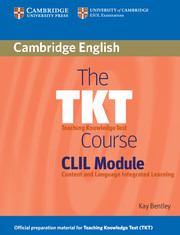Unit 11 - Classroom language
Published online by Cambridge University Press: 27 September 2023
Summary
How do teachers and learners use language in the CLIL classroom?
CLIL classrooms are places where learners can develop speaking and writing skills as well as become knowledgeable about subjects from the curriculum. The CLIL classroom should provide opportunities for interaction between teacher and learners as well as between learners and other learners. Learners therefore need to understand and to produce a wide range of language early in CLIL programmes. Teachers need to think about the language they use and think about how to help develop the spoken and written language of their learners.
Key concepts
Think of reasons for your use of the target language in the classroom. How do you present subject knowledge? How do you encourage thinking and learning? How do you manage the classroom?
We can help learners if we are aware of the purpose of our classroom language and if we repeat the language during lessons. Learners then become familiar with the functional language so it is easier for them to focus on subject content and tasks. Consider the language you use when you:
activate prior knowledge
present new ideas
encourage learners to collaborate
develop learners’ understanding
try to find out if there are any difficulties with subject content
help learners develop thinking skills and make links
encourage creative talk
monitor learning (observe and listen to learners as they work in the classroom)
respond to learning needs.
To find out more about grading and sequencing questions and instructions, see Unit 26 of The TKT Course.
Key concepts and the CLIL classroom
How can we develop our classroom language?
Most teachers recognise that questioning is an important part of a learning classroom. ‘Questioning is at the heart of learning and teaching’ (Fisher, 2005). We therefore need to develop our questioning skills to encourage dialogue with our learners. We also need to develop the skill of choosing the right question for the right task, as this is central to the development of classroom language.
When asking or writing closed questions (those with only one correct answer), the focus is often on remembering or revisiting key content vocabulary, so learners use mostly lower order thinking skills for responding.
- Type
- Chapter
- Information
- The TKT Course CLIL Module , pp. 64 - 68Publisher: Cambridge University PressPrint publication year: 2010



